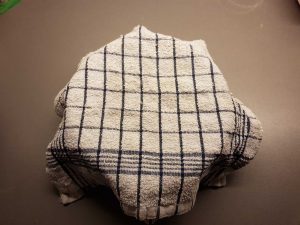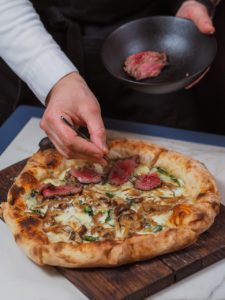There are endless possibilities when it comes to pizza toppings. From the type of topping you choose and the amount you use, to the order you add them to your pizza. Each step matters in order to create the perfect pizza. Topping your pizza the wrong way will make a soggy pizza with boiled toppings. So here’s how to top your pizza the right way, so it turns out perfect every time!
The right order of pizza toppings
What is the correct order to put your toppings on a pizza? Does the tomato sauce or cheese go first? Or should the cheese go last, covering all the other ingredients?
The classic, Neapolitan way of topping a pizza is to start with the sauce, followed by cheese, and lastly other toppings and garnishes.
Why should you top your pizza in this order?
Does it even matter which topping you add first? The truth is that it does. Order is important to make good pizza. If you top your pizza in the wrong order, you’ll end up with a soggy crust and boiled toppings.
The right order of pizza toppings is essential for letting moisture evaporate in the oven to make a crispy crust, melted cheese, and well-baked toppings.
A mistake I see all the time is putting the cheese on top of everything else. This is not a good idea because when the cheese melts, it will cover both the sauce and toppings and trap moisture. This moisture will evaporate when you bake your pizza in the oven. But when it has nowhere to go, it will be stuck, making your pizza soggy. Getting rid of excess moisture during baking is necessary to make crispy pizza.
The trapped moisture will also boil, or steam the toppings. I don’t know about you, but I’m not a huge fan of boiled pepperoni. So by placing the toppings on top of the cheese, you will bake them, rather than boiling them. Something that will give a better consistency and flavor.
The reason the sauce goes on before the cheese is that covering the sauce prevents the cheese from melting and spreading evenly throughout the pizza. And if you put the sauce on top, too much moisture can evaporate and give your sauce a tomato paste constancy.
So the best way to top a pizza is:
- Sauce
- Cheese
- Toppings
The appeal is also worth mentioning. A pretty pizza does taste better than an ugly one!
How to top a pizza step-by-step
First, you need to prepare your pizza base. You can find a recipe here.
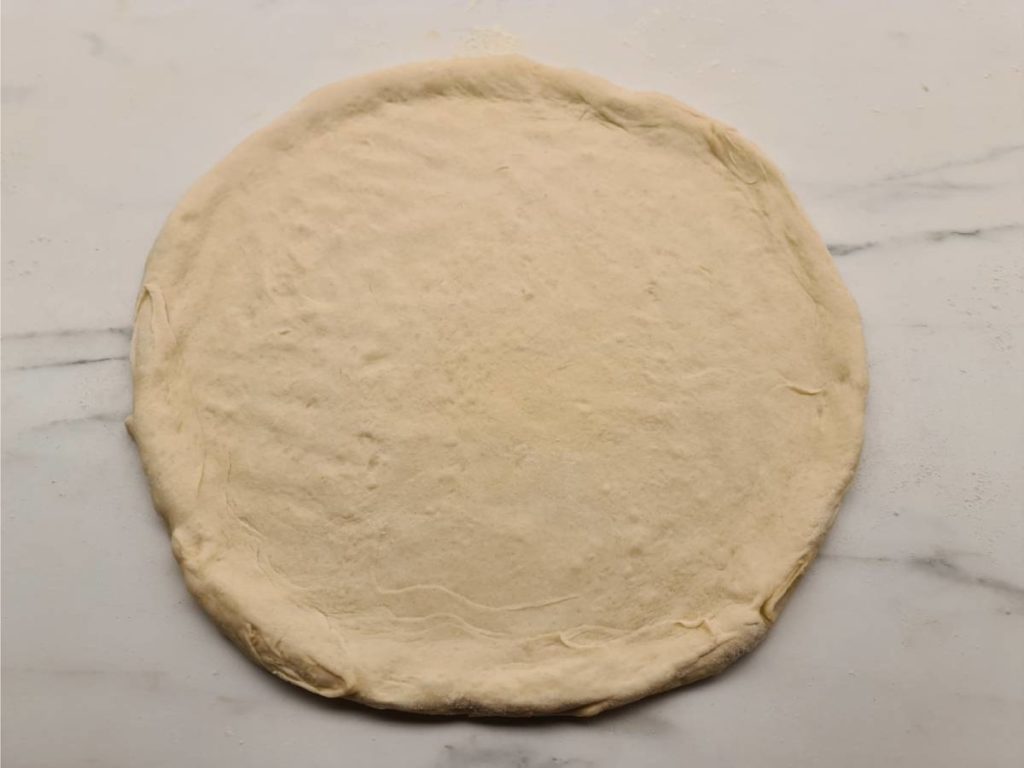
1. Add sauce
The first thing you want to do is to add the sauce. Click here if you need an easy pizza sauce recipe.
Ladle sauce in the center of the pizza.
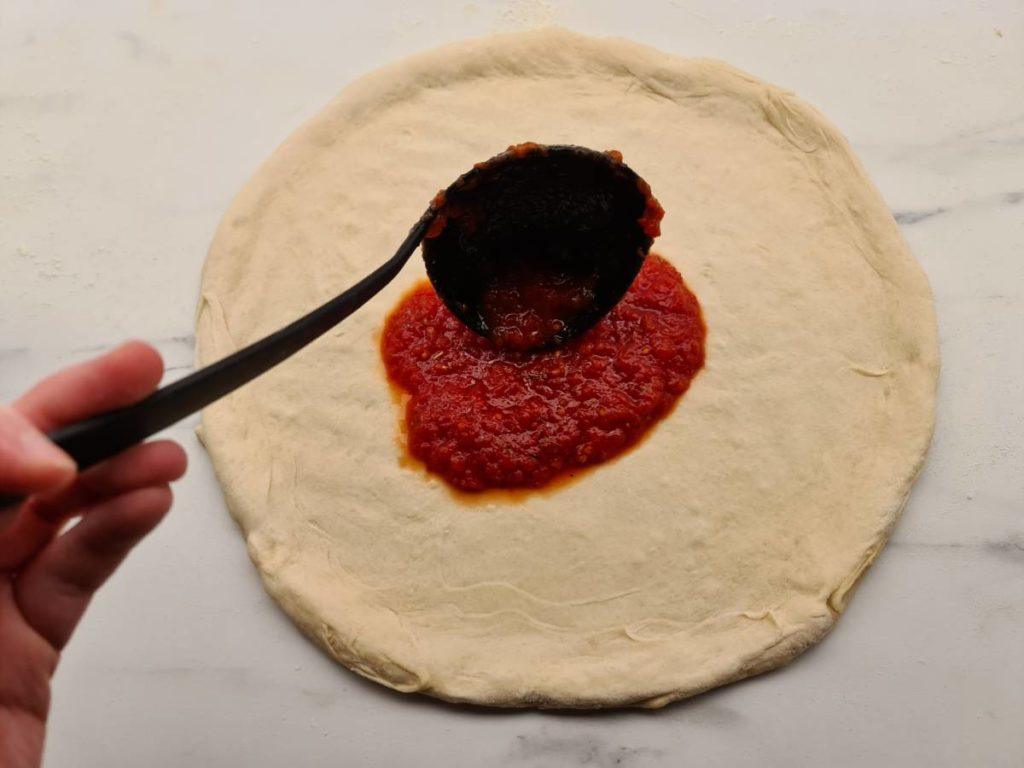
Spread the sauce evenly with a spiral motion from the center outwards to the rim. But you don’t want to put sauce on the rim to let it puff up and make a nice crust in the oven.
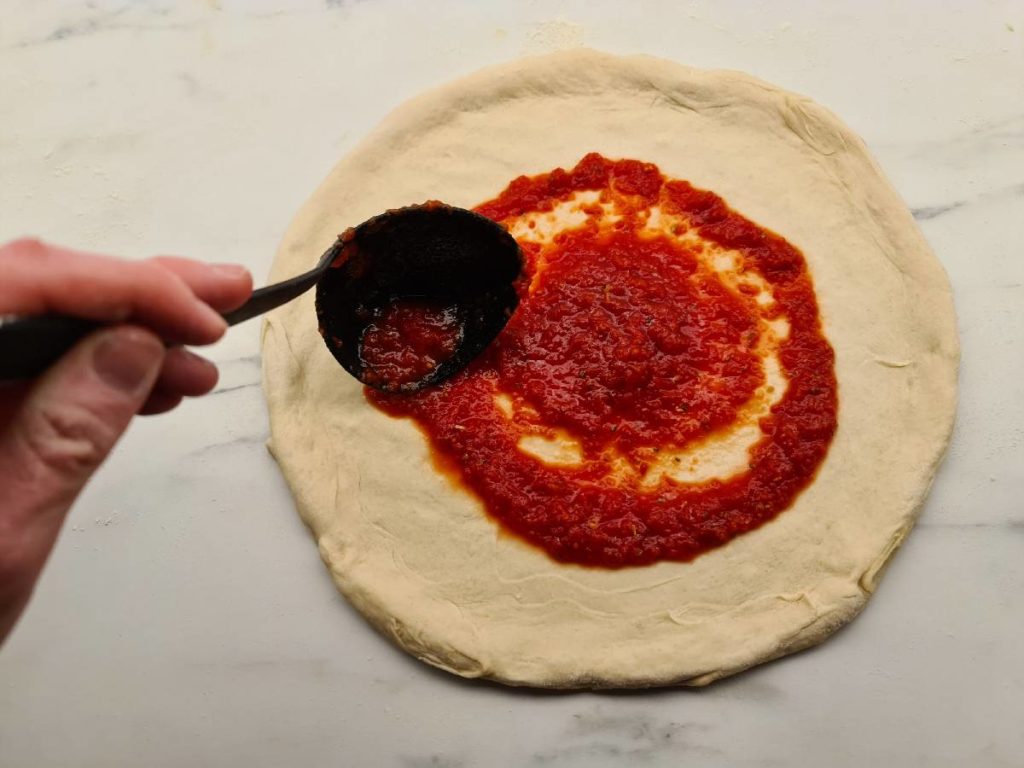
Make sure the sauce is spread evenly.
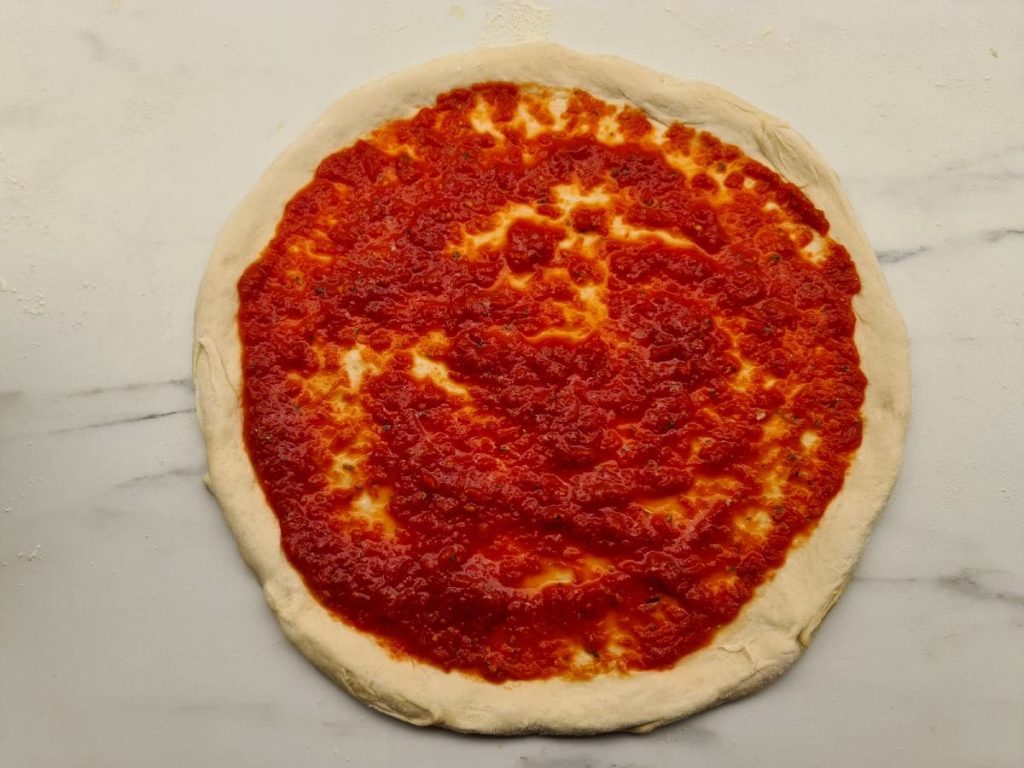
2. Cheese
Next, spread the cheese evenly throughout the pizza.
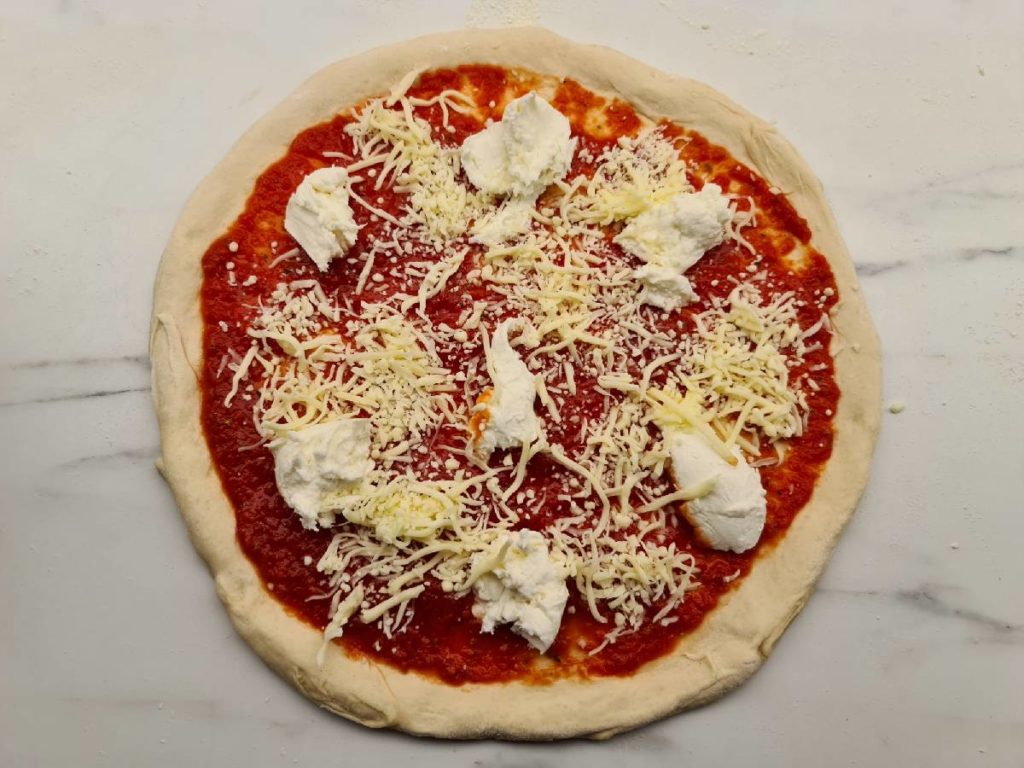
3. Toppings
Finally, add your pizza toppings. Start with the thinnest slices of meat (such as salami and pepperoni), followed by larger pieces of meat, and vegetables with the highest water content last to let more moisture evaporate in the oven.
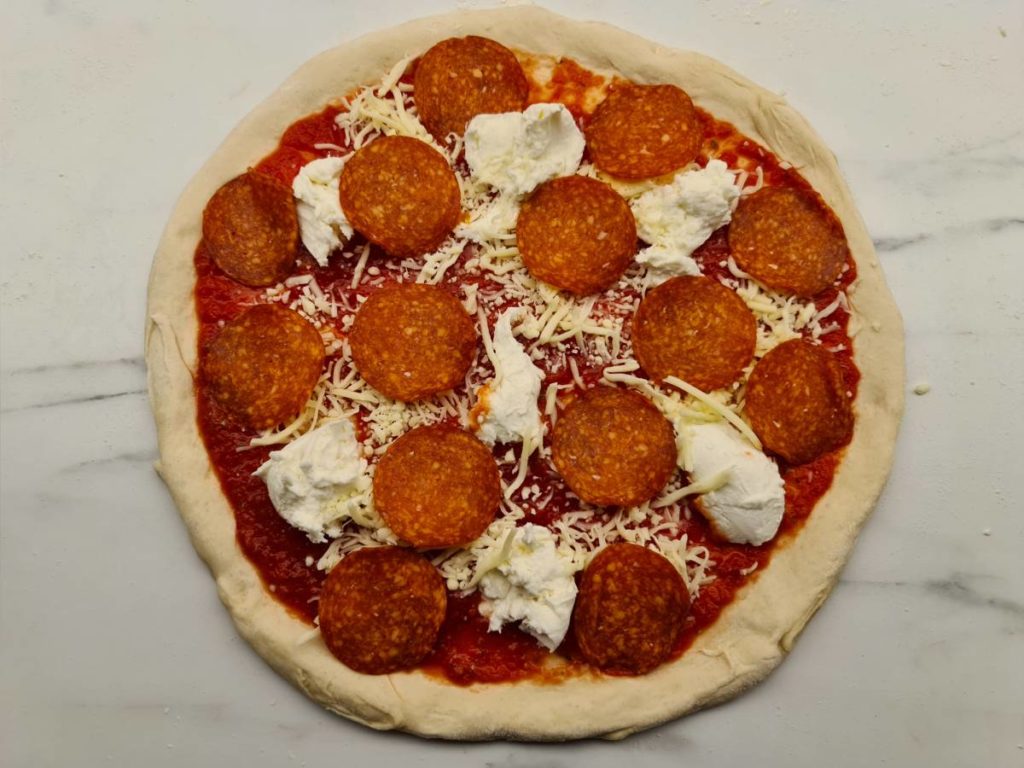
Now you have a perfectly topped pizza that’s ready for the oven.
4. Post-bake garnish
After the pizza comes out of the oven, add any post-bake toppings, such as fresh vegetables, and Prosciutto.
Adding toppings before or after baking the pizza
Certain ingredients should be added after baking, rather than before. You don’t want to add ingredients that can’t handle the heat from the oven before baking. The same goes for ingredients you want to taste fresh, or don’t want to heat.
Examples of toppings you want to put on the pizza after baking are rocket and salads that you want to eat fresh or Prosciutto (uncooked, cured ham) that you don’t want to cook.
Which pizza toppings should you add after baking?
Here’s a list of pizza toppings you want to add after baking:
- Salad
- Rocket leaves
- Basil
- Prosciutto
- Olive oil (to preserve flavor)
Pre-cooking toppings
Do you need to pre-cook toppings before adding them to the pizza?
You should pre-cook meat and other toppings that need to be heat-treated for safety reasons. You can also pre-cook fatty meat to render fat to avoid a greasy pizza, and toppings with a high water content to release moisture that makes the pizza soggy.
For safety reasons, you need to cook some ingredients before adding them. Even if the oven is piping hot, you want to bake your pizza fast to make it crispy and nice. So the short time in the oven might not be enough to cook through all types of meat properly. Especially pork and chicken should be cooked before adding them to your pizza, to make sure they’ve reached the right core temperature and are safe to eat.
Some types of meat also contain a lot of fat, such as bacon. This extra fat will render in the oven and make your pizza greasy. You can fix this by pre-cooking fatty meat to render some of the excess fat before you top your pizza.
Vegetables and mushrooms often contain a lot of water. And if you add these to your pizza, it will make it soggier. So pre-cooking these toppings will get rid of some of the moisture and ensure your pizza ends up crispy.
Which topping to add first and last
Another question I’m often asked is which topping or garnish goes first on top of the chees. Should you add the pepperoni first or the olives?
The right order of garnishes:
- Thin slices of meat
- Larger pieces of meat
- Low moisture vegetables
- High moisture vegetables
If you have multiple types of meat you should put thinner pieces of meat, such as salami or pepperoni first. And the larger chunks of meat on top. The reason is that the bigger piece of meat needs more heat to cook through. And you also typically want a nice, browned surface on them. By placing them on top, you also protect the thinner slices from burning.
For vegetables, you should start with the vegetables that contain the least moisture first. Then add higher moisture vegetables on top. This will make sure more of the excess moisture in the vegetable evaporate during baking and prevents the pizza from getting soggy.
Topping combinations
There are a million ways to combine toppings. Different types of sauce, different types of cheese, different types of meat and vegetables. But the most important thing for a successful pizza is balance.
The most important things to consider when combining pizza toppings are:
- Don’t overtop the pizza
- Balancing flavors and saltiness
- Don’t add too many fatty or watery toppings
The most common mistake is overtopping. If you overtop your pizza, it will take much longer to cook and it will end up soggy. The reason you don’t want to bake the pizza very long is that the crust will dry out, and the toppings can burn before the bottom is fully baked.
You also want to think of what flavors go well together. And that’s easier if you limit yourself to 3 types of topping, and don’t add everything you can think of. Limiting the number of toppings also makes it easier to not overtop your pizza.
Another thing to consider when you pick ingredients is to balance the salt, fat, and moisture of your toppings. If you fill your pizza with salty pepperoni, perhaps you don’t want to add too many salty olives. Adding too much fat will make it greasier. Too watery toppings will take longer to bake and prevent crispiness, like overtopping.
Classica Italian pizza topping ideas
Some classic Italian pizza toppings:
- anchovies
- basil
- chili peppers
- garlic
- olives
- olive oil
- parmesan and pecorino cheese
- salami
Neapolitan pizzas
Here are some of the most popular Neapolitan pizza topping combinations:
- Pizza Margherita (mozzarella, basil, olive oil, and pecorino)
- Pizza Marinara (garlic, olive oil, and oregano)
- Pizza Diavola (mozzarella, spicy salami, sliced chili peppers, and black olives)
Related
- Ooni Turning Peel Review: The Best Peel for Home - April 15, 2024
- Gi.Metal Turning Peel Review: Is This the Ultimate Pizza Tool? - April 14, 2024
- Discover Pizza Mastunicola: The Story of the First Pizza - April 7, 2024
